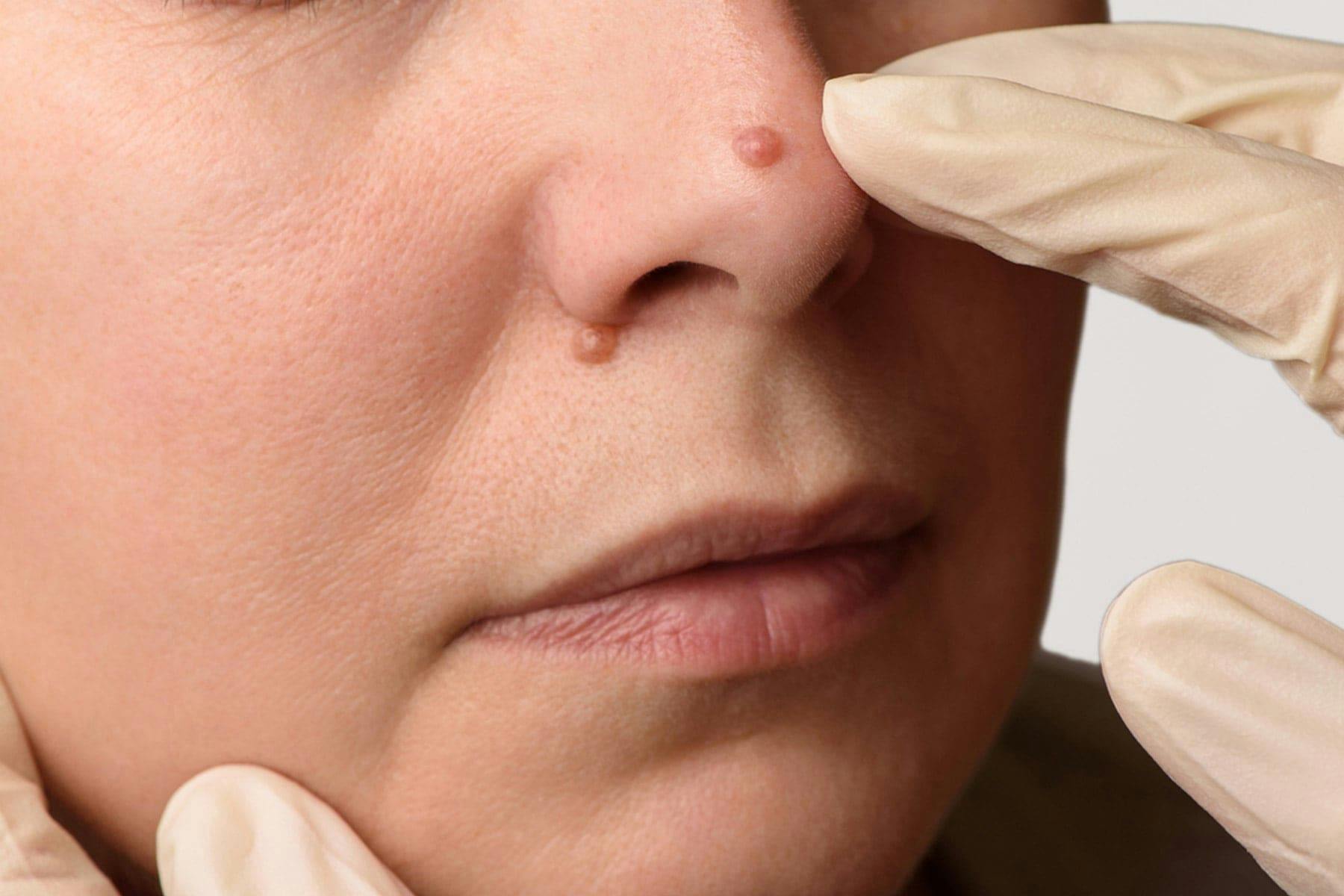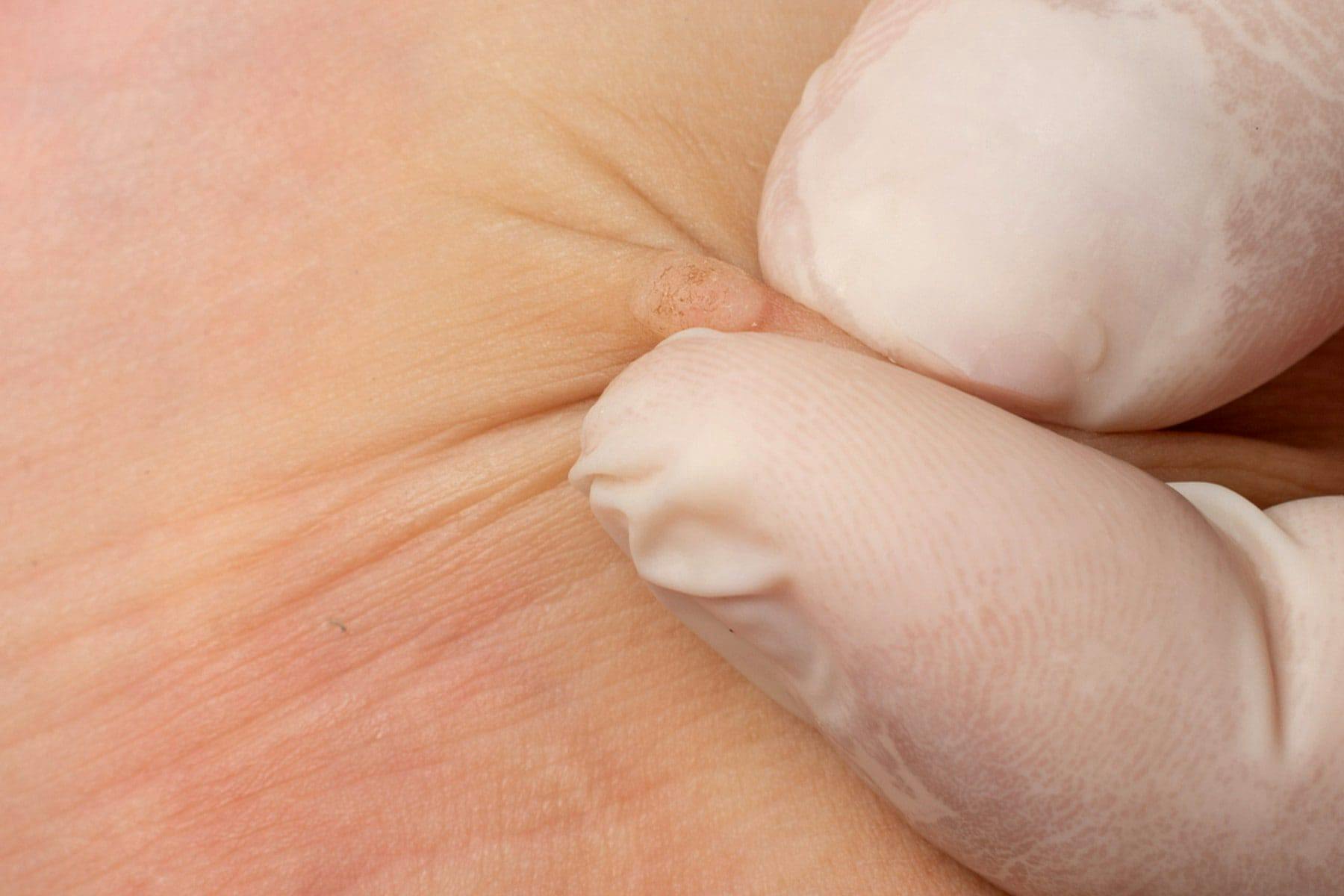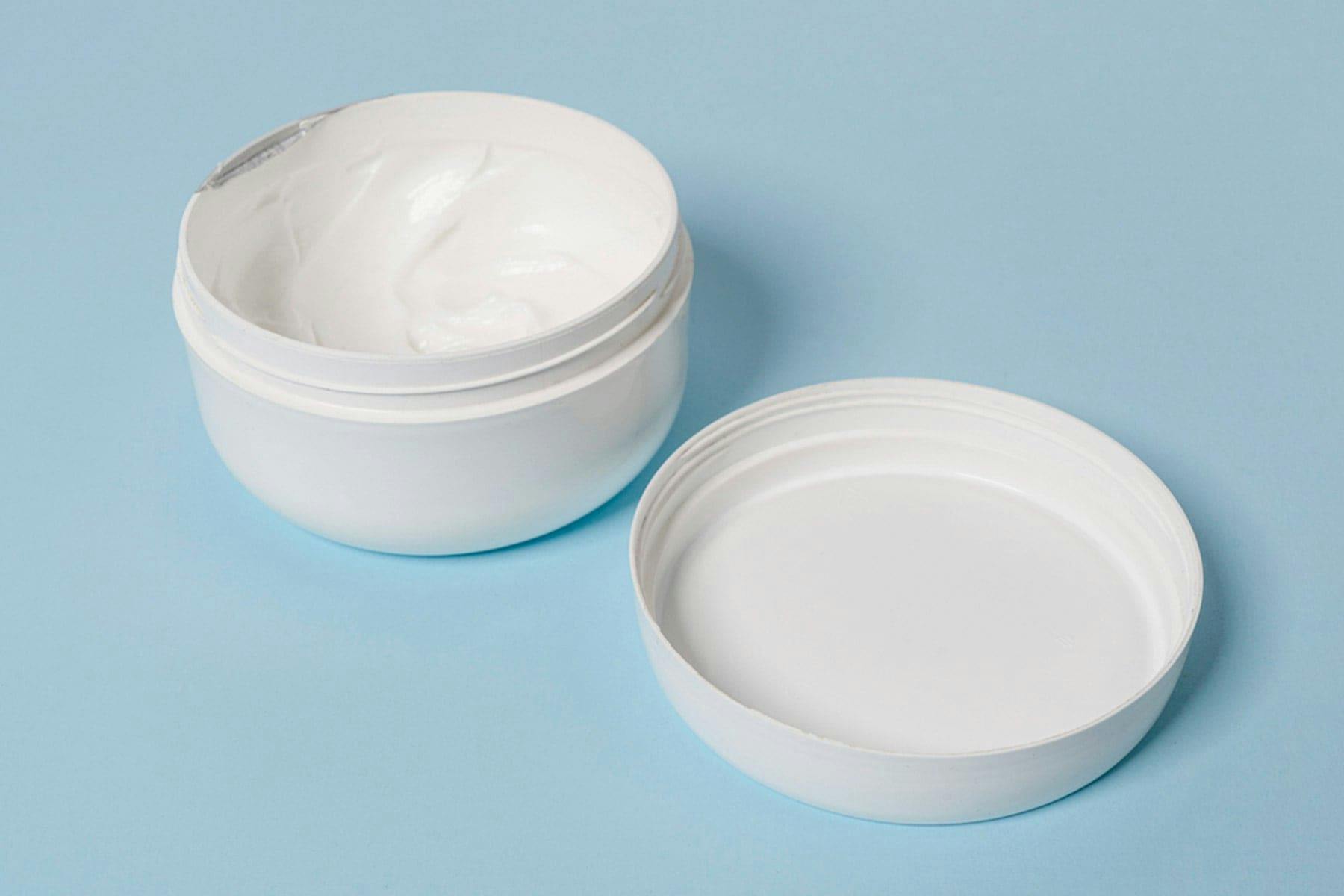Your Family Deserves the Best Care Book an Appointment
Your skin health matters, so don’t delay. Our clinicians look forward to treating you and your family at one of our local New England practices.
Find Your Nearest APDerm CenterFlat warts, also known as verruca plana or plane warts, are a type of skin wart caused by specific strains of the human papillomavirus (HPV). These warts are characterized by their flat, smooth, and slightly raised appearance on the skin, which distinguishes them from other types of warts, such as common warts or plantar warts. They are typically small and flesh-colored, measuring between 2 to 4 millimeters in diameter, and they often appear in clusters or groups on various parts of the body. These areas can include flat warts on the face, neck, hands, wrists, and knees. Flat warts can also be found on the legs of children.

The HPV strains responsible for flat warts are usually from the low-risk HPV types, primarily HPV types 3, 10, 28, and 49. These strains of HPV have a preference for causing benign warts, including flat warts, rather than more concerning conditions like cervical cancer, which is often associated with high-risk HPV strains. It is important to note that flat warts are contagious and can spread through direct skin-to-skin contact with an infected person or by touching surfaces contaminated with the virus. Although flat warts are typically devoid of pain, they can cause itching or irritation, particularly when subjected to scratching.
Therefore, we recommend covering them if possible as a precautionary measure, and if necessary, seeking medical assistance for suitable treatment. Treatment for flat warts may not always be necessary, as they can resolve on their own over time; however, some people opt for removal due to cosmetic concerns or if the warts become bothersome. Prevention, on the other hand, involves practicing good hygiene, avoiding skin-to-skin contact with infected individuals, and using precautions in shared spaces like locker rooms to reduce the risk of HPV transmission and flat wart development.

Although the symptoms associated with flat warts can vary among individuals (for instance, not all individuals will necessarily experience itching or irritation), if you suspect you have flat warts or notice any unusual skin growth, we strongly recommend seeking a medical assessment for an accurate diagnosis of flat warts and exploring treatment options aimed at alleviating symptoms.
As the name suggests, flat warts have a flat, smooth, and slightly raised surface compared to other types of warts. They are typically flesh-colored or slightly pink and may appear lighter or darker than the surrounding skin. Flat warts acquire their flat appearance because they grow horizontally within the layers of the skin, primarily in the top layer known as the epidermis, rather than projecting outward like some other wart types (like common warts, for example).
Flat warts are notably small in terms of their physical characteristics. Their diminutive size sets them apart from other wart varieties, which can often be more substantial. Another distinguishing feature is their tendency to cluster together in groups, creating a mosaic-like pattern. This clustering behavior can draw attention to flat warts, especially when they emerge on visible areas like the face or hands, possibly prompting individuals to seek treatment.
Flat warts can manifest on various parts of the body, with common areas including the face, neck, hands, wrists, and knees. In children, they may also appear on the legs due to factors such as close skin contact, scratching, and their developing immune system. Flat warts are contagious and can spread through direct contact with the skin of an infected individual. Therefore, promoting good hygiene practices and seeking medical advice for any skin irregularities are crucial steps.
Flat warts are typically painless growths, distinguishing them from certain other skin conditions that can be uncomfortable or sore. This lack of pain often comes as a relief to those affected by flat warts, as they usually do not interfere with daily activities. However, they may become itchy or irritated, particularly if subjected to scratching or agitation. Seeking medical guidance or evaluation for suitable flat wart treatment and management can effectively address these symptoms.
Flat warts are contagious and can be transmitted through direct skin-to-skin contact or by touching surfaces contaminated with the virus. Consequently, they can sometimes multiply and spread to adjacent skin areas. Children are particularly vulnerable due to their developing immune systems and frequent involvement in physical activities and close interactions with others in environments like schools or daycare centers, which heightens their susceptibility to skin-to-skin contact.
Flat warts are notorious for their persistence, often lingering for extended periods and sometimes resisting resolution for months or even years. This extended presence can be frustrating for individuals coping with these warts. While flat warts do have the potential to resolve on their own, there is no fixed timetable for their disappearance. The variability in resolution time is influenced by factors such as individual immune responses, the specific HPV strain responsible for the warts, and their location on the body.


Flat warts are caused by specific strains of the human papillomavirus (HPV). HPV is a group of viruses that can infect the skin and mucous membranes, and flat warts are primarily associated with low-risk HPV types (notably, HPV types 3, 10, 28, and 49). As previously mentioned, these particular HPV strains are more inclined to produce benign warts, such as flat warts, as opposed to the more severe conditions typically associated with high-risk HPV strains, such as cervical cancer. The HPV virus typically enters the skin through small breaks or cuts, often too tiny to be visible to the naked eye. Once inside the skin, the virus infects the cells of the epidermis (i.e. the top layer of the skin) and causes the cells to rapidly multiply, leading to the formation of flat warts. Flat warts are contagious, meaning they can be spread from person to person through direct skin-to-skin contact or by touching contaminated surfaces or objects, and this mode of transmission is often why flat warts appear in clusters or groups, especially in areas where there is frequent skin contact like on the face, neck, hands, wrists, and knees.
It is important to note that while HPV is the primary cause of flat warts, other factors such as genetics, immune system function, and skin trauma (like scratching or cuts) can also influence whether or not an individual develops these warts after exposure to the virus. For example, children are more prone to scratching itchy skin or sustaining minor skin injuries while playing or exploring. Therefore, the virus can more easily enter through breaks in the skin, facilitating the development of flat warts. Children, especially younger ones, also have developing immune systems that are less effective at fighting off infections, including HPV. In light of this, parents and caregivers need to teach good hygiene practices to children, encourage them to avoid touching or scratching warts, and seek medical advice if they suspect any skin abnormalities.
Diagnosing a flat wart generally involves a clinical assessment by a healthcare professional or dermatologist. They will carefully examine the affected area of your skin, looking for the distinctive characteristics that set flat warts apart from other skin conditions. These characteristics include the flat, smooth, and slightly raised appearance of the warts, which can provide valuable diagnostic clues. During this evaluation, your healthcare provider may also inquire about your medical history. They might ask questions about the timeline of when the warts first appeared, any associated symptoms, and whether you have had recent skin-to-skin contact with individuals who have warts. In some cases, a dermatoscope (a handheld device that allows for closer skin examination) may be used to enhance the diagnostic process – this tool can provide more detailed information about the wart’s appearance, aiding in a precise diagnosis.
However, while flat warts are typically identifiable based on their characteristic appearance, in some instances where uncertainty exists or if there’s suspicion of a different skin condition, a biopsy might be recommended. A biopsy involves taking a small tissue sample from the wart for closer examination under a microscope. This step helps confirm the diagnosis and rule out any other underlying skin issues.
If you are uncertain about a growth on your skin or if you notice any changes in the wart’s appearance, it is crucial to consult a healthcare professional or dermatologist for a thorough evaluation and accurate diagnosis. This approach is particularly important to ensure that more serious skin conditions that mimic flat warts are ruled out. Once diagnosed, your healthcare provider can then discuss suitable treatment options with you, and if necessary, guide flat wart management and prevention.
You may be questioning at this point whether flat warts and plantar warts are the same, but it is essential to clarify that flat warts are distinct from plantar warts. These two types of warts are driven by different strains of HPV, and their distinct locations and appearances are key differentiators. Flat warts, as the name suggests, have a flat and smooth profile. They tend to make their presence known in areas such as the face, neck, hands, and knees.
Their growth pattern is characterized by horizontal development within the top layer of the skin. However, unlike flat warts, plantar warts find their home exclusively on the soles of the feet. Here, they have a different growth pattern, often penetrating inward into the thick skin due to the pressures of walking and standing. This inward growth gives plantar warts a raised and sometimes rough surface, which is a noticeable contrast to flat warts’ smoother appearance.
Another critical point of differentiation is the sensation they evoke. While flat warts are typically painless, plantar warts can be uncomfortable when pressure is applied to them. Therefore, despite their shared origin from various HPV strains, these warts have their own distinct characteristics and effects on the body. This is why an accurate diagnosis matters!


The selection of treatment options for flat warts can be quite diverse, reflecting the personalized approach to managing warts. Indeed, the suitability of a specific treatment method is influenced by a combination of factors, including the unique characteristics of the warts and the preferences of the individual seeking treatment. However, the location of the flat warts on the body is also a significant factor that guides the selection of the most appropriate treatment approach. One common approach to treatment involves the use of topical medications. These medications can be available over-the-counter (OTC) or prescribed by a healthcare professional. Topical treatments typically come in the form of creams, gels, or ointments, many of which contain active ingredients such as salicylic acid or retinoids. When consistently applied directly to the flat warts, these agents work by gradually breaking down the wart tissue, ultimately leading to their removal. Cryotherapy represents another frequently employed treatment method for flat warts. This procedure involves freezing the warts using liquid nitrogen, a technique often administered by healthcare providers or dermatologists. Cryotherapy is known for its effectiveness in treating warts and can yield positive results; however, in certain cases, electrocautery may be recommended.
During electrocautery, healthcare providers employ an electrical current to burn flat warts off – this procedure is typically performed in a medical setting and can prove effective for particular cases of flat warts. Laser therapy offers an alternative route, particularly suitable for extensive or stubborn flat warts. By targeting the blood vessels that supply the warts, lasers effectively destroy them, offering a reliable method for wart removal. Finally, prescription medications, such as topical treatments like imiquimod or tretinoin, may be considered if other treatment approaches have proven ineffective or when flat warts are in more sensitive or challenging locations.
For larger or exceptionally resistant flat warts, minor surgical procedures can be recommended by a healthcare provider. These procedures typically involve the surgical removal of flat warts under local anesthesia and options include cutting or scraping the flat warts, depending on the individual’s unique case. Chemical peels represent yet another option in the arsenal of flat wart treatments.
Similarly, this method is often considered when flat warts do not respond to other treatment approaches, and entails the removal of the top layer of skin where the flat warts appear. In specific situations, immunotherapy may also be explored, which is why it is imperative to seek medical advice on suitable flat wart treatments. Immunotherapy leverages medications or substances designed to stimulate the body’s immune system, producing an enhanced immune response that targets and eliminates the warts.
While certain individuals may try home remedies like duct tape occlusion therapy, it’s essential to exercise caution and consult a healthcare provider if flat warts persist or prove resistant to other treatments. It’s worth noting that the effectiveness of these home remedies can vary, and incorrect usage may result in complications or scarring.
Like all warts, preventing flat warts can prove challenging due to their high level of contagiousness. However, there are steps you can take to lower your chances of acquiring the virus and subsequently developing flat warts. These include the following:
Frequent handwashing with soap and water can play a role in diminishing the likelihood of HPV transmission via direct skin-to-skin contact or by coming into contact with surfaces that might be contaminated with the virus.
Refraining from touching flat warts is crucial in preventing the spread of HPV, both within your own body and to others. This precaution helps minimize the chances of developing new flat warts and reduces the risk of spreading the virus.
If you have a flat wart, avoid scratching or picking at it. Instead, keep the flat wart covered with a bandage or tape to prevent accidental contact and to reduce the risk of spreading the virus.
Do not share items like towels, razors, or nail clippers with others, as these can potentially transmit the virus if they come into contact with infected skin. Remember: early intervention can help reduce the risk of the flat warts spreading!
Consider getting the HPV vaccine. While it primarily targets high-risk HPV strains associated with cervical cancer, it can also provide some protection against low-risk strains that cause flat warts.
A strong immune system can help your body fight off HPV infections. Maintain a healthy lifestyle with a balanced diet, regular exercise, and adequate sleep to support your immune system.
HPV is exceptionally contagious, and it’s essential to acknowledge that despite taking precautions, absolute prevention may not always be achievable. Nonetheless, by adhering to these preventive measures, you can lower your chances of contracting flat warts and other conditions related to HPV. In case you have any concerns or queries about flat warts or HPV, seeking advice from a healthcare provider is advisable. They can offer guidance, appropriate care, and assess whether the HPV vaccine is suitable for your circumstances.

When it comes to flat warts, seeking medical assistance is crucial in several situations. If you are unsure about the nature of a skin growth, experiencing pain or discomfort from the warts, or finding that they persist despite initial treatment efforts, it is advisable to consult a healthcare provider. This recommendation extends to instances where the warts spread, multiply, appear in visible or sensitive areas, or if you have a weakened immune system.
Additionally, if concerns arise about the warts’ appearance or if you encounter persistent itching or irritation, seeking professional medical guidance is a vital step to ensure a proper diagnosis and effective treatment. The decision regarding the appropriate treatment method should ideally be made in consultation with a healthcare provider or dermatologist.
Healthcare professionals can conduct a comprehensive assessment of the specific condition, taking into account factors like the characteristics of the warts and their location, to help determine the most suitable course of action.
Self-treatment is not always advisable, particularly when dealing with warts in sensitive or delicate areas, as this can potentially lead to complications. Therefore, seeking medical advice is recommended.
Vaccination against specific HPV strains can also be a valuable tool in wart prevention. However, it’s important to note that these vaccines primarily focus on high-risk HPV strains linked to cancer, rather than the low-risk strains responsible for most warts, including flat warts. Therefore, while vaccination can protect against certain types of warts, it may not completely eradicate the risk of developing flat warts.

Your skin health matters, so don’t delay. Our clinicians look forward to treating you and your family at one of our local New England practices.
Find Your Nearest APDerm CenterWe use cookies and other tools to enhance your experience on our website and to analyze our website traffic. For more information about these cookies and the data collected, please refer to our Privacy Policy.